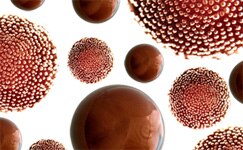
Quantitative measurement of triiodothyronine (T3) |
Request Information |

Radioimmunoassay techniques are used in vitro for the quantitative measurement of triiodothyronine (T3). It depends on competition between T3 (red) present in the sample and 125I-labelled T3 (orange) for a limited number of binding sites on a sheep anti-T3 antibody (blue) bound to magnetisable polymer particles (Figure 1).
Separation of the antibody-bound fraction is effected by magnetic separation, followed by decanting of the supernatant.
The amount of tracer (radiolabel or fluorescent) bound is inversely proportional to the concentration of T3 present.
In competitive test, utilisation of large particles (> 1.2 µm) is preferable and allows a better signal or sensitivity.
The Estapor® Magnetic Microspheres are, in fact, super paramagnetic materials. The magnetization of the microspheres increases with the applied magnetic field and falls back to zero when the field is removed.
From this point, the microspheres demagnetize and redisperse easily. This property allows efficient washing steps, low background and good reproducibility.
Our Magnetic Microspheres are perfectly suited for immunoassays applications:
| Tests | Analytes |
|---|---|
| Adrenal/pituitary | Cortisol |
| Anaemia | Ferritine, Folate, Vit B12, EPO |
| Bone metabolism | Intact PTH |
| Diabetes | Insulin |
| Drug of abuse (DOA) | Cocaine, morphine, THC |
| Fertility | Beta-HCG, LH, FSH, Estradiol, Progesterone, Testosterone |
| Thyroid | T3, T4 (Free, Total) |
| Tests | Analytes |
|---|---|
| Allergy | Ig E |
| Auto-immune | ANA, ds, ADN Ab |
| Blood virus | HAV, HBV (HBs,HBe, HBc), HCV, HIV |
| Cancer | PSA (prostate) |
| Cardiac markers | FABP, proBNP, Troponin, Digoxin, CKMB, Myoglobin |
| Infectious diseases | CMV, Rubella, Toxoplasma |
| Inflammation | IL-6 |
For CLIA development, SuperParamagnetic microspheres with different surfaces (plain, COOH, NH2, CH2Cl, OH, tosyl, or bioactivated), different sizes (0.30-2.60 µm), and different ferrite contents (10 – 70%) are required.





